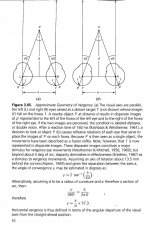David,
That's very interesting, particularly since the one issue that probably causes more headaches than any other is collimation. At least that's been my experience.
Are you poo-pooing the limits specified in the SPIE Field Guide to Binoculars and Scopes? It seems like you're talking about at least an order of magnitude difference.
Ed
Ed,
Using a roof for usually less than 5 minutes at a time is going to be very different hours of serveilance with a porro. Bescides those two, I've probably only seen a handfull that felt like they were giving me immediate eyestrain out of many hundreds I've tried.
I've not found the notes I made at the time, but it my memory serves me right, out of 5 roofs I tried with this method, the maximums I got just under half a degree (~25 arcminutes) convergence. 1.3° (78') divergence and 2° (120') dipvergence. Given the crude method, the dipvergence would be least reliable.
That miltary spec has no tolerance for convergence, but we've been told convergence was deliberately employed for an Avimo British/NATO binocular. My divergence value is about two and a half time the military max and I accept my dipvergence figure may be high.
The SPIE field guide says civilian binoculars may exceed those limits so I see nothing particularly contradictory in the values..
The point I was making about those two I received with obvious dipvergence was that, for me the centre performance was unaffected as far as determine, and although I could easily see the misalignment, I could comfortable ignore it as well. You may well differ, but if my test is at all representative of mid range binoculars ( and I accept it may not be) then most users would appear to be quite tollerant.
David






